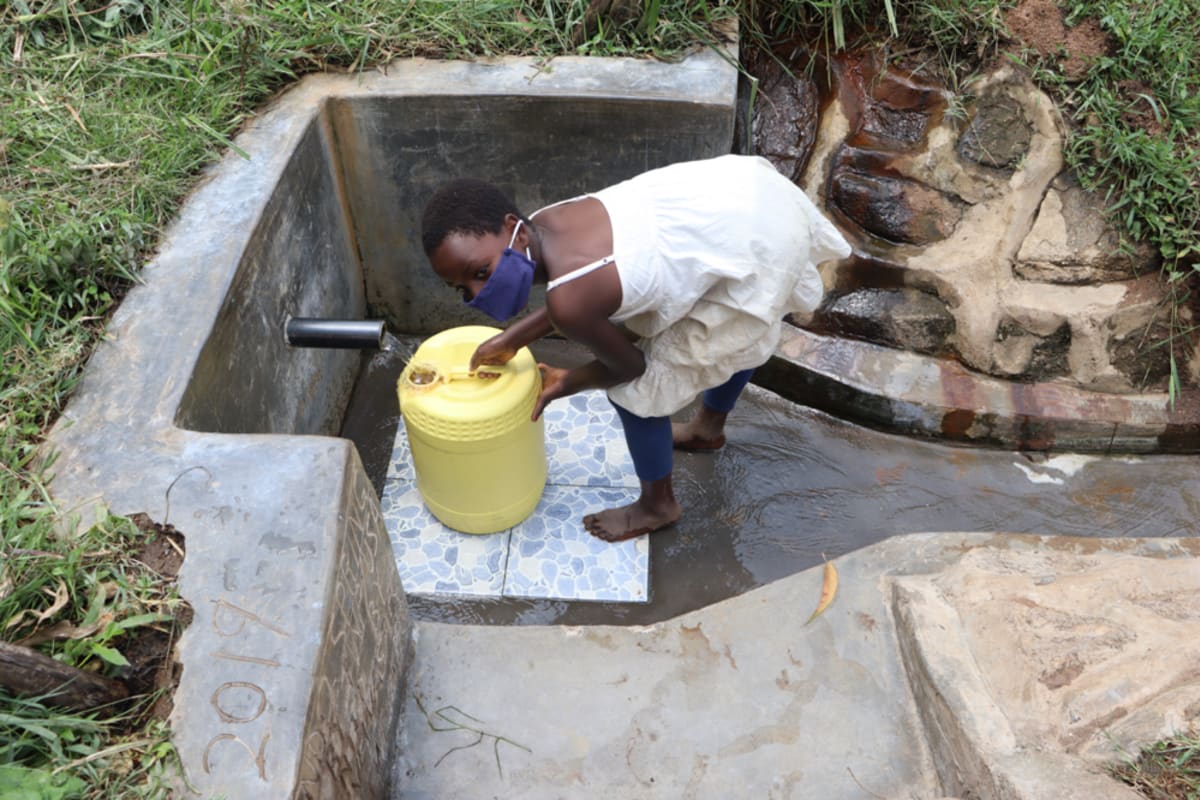June, 2020: COVID-19 Prevention Training Update at Maondo Community, Ambundo Spring
Our teams are working on the frontlines of the COVID-19 pandemic. Join us in our fight against the virus while maintaining access to clean, reliable water.

Trainer Jacky fills a handwashing station with water
We are carrying out awareness and prevention trainings on the virus in every community we serve. Very often, our teams are the first (and only) to bring news and information of the virus to rural communities like Maondo, Kenya.
We trained more than 17 people on the symptoms, transmission routes, and prevention of COVID-19. Due to public gathering concerns, we worked with trusted community leaders to gather a select group of community members who would then relay the information learned to the rest of their family and friends.

We covered essential hygiene lessons:
- Demonstrations on how to build a simple handwashing station
- Proper handwashing technique
- The importance of using soap and clean water for handwashing
- Cleaning and disinfecting commonly touched surfaces including at the water point.

We covered COVID-19-specific guidance in line with national and international standards:
- Information on the symptoms and transmission routes of COVID-19
- What social distancing is and how to practice it
- How to cough into an elbow
- Alternative ways to greet people without handshakes, fist bumps, etc.
- How to make and properly wear a facemask.

During training, we installed a new handwashing station with soap near the community’s water point, along with a sign with reminders of what we covered.
Due to the rampant spread of misinformation about COVID-19, we also dedicated time to a question and answer session to help debunk rumors about the disease and provide extra information where needed.

Homemade mask tutorial
We continue to stay in touch with this community as the pandemic progresses. We want to ensure their water point remains functional and their community stays informed about the virus.

Prevention reminders chart installed at the spring
Water access, sanitation, and hygiene are at the crux of disease prevention. You can directly support our work on the frontlines of COVID-19 prevention in all of the communities we serve while maintaining their access to safe, clean, and reliable water.

March, 2020: Maondo Community, Ambundo Spring Project Complete!
Maondo Community now has access to clean water! Ambundo Spring has been transformed into a flowing source of water thanks to your donation. We protected the spring, constructed 5 sanitation platforms for different households in the community, and we trained the community on improved sanitation and hygiene practices.

Kids celebrate unity over the clean water
"The new water point has brought us together and brought peace which was destroyed by family issues. I take this opportunity [to thank] all who thought of us and decided to bail us through this. This water point will give us an opportunity to get clean and safe water which we have been yearning to have for the many years we have lived in this community. Diseases such as typhoid, diarrhea, and even cholera which we have experienced will no longer be heard of...I am therefore happy and pleased to thank each and everyone who ensured that the spring came to completion," said Rabecca Musungu, a local farmer.

Girls posing with the newly protected spring
Spring Protection
Community members provided all locally available construction materials, including bricks, wheelbarrows of clean sand, stones, and fencing poles. Accommodations and meals were provided for the artisan, too. Despite some of the internal challenges and disagreements community members had with each other, they resolved to work together to ensure that they would have safe, clean water. Even when some of the original materials the community provided were rejected by the artisan due to poor quality, they worked together to source new materials and make sure the work would get done.

Community members carry large stones to the spring construction site
The Process
Women and men lent their strength to the artisan to help him with manual labor. The spring area was excavated to create space for setting the foundation of thick plastic tarp, wire mesh, and concrete. After the base had been set, both wing walls and the headwall were set in place using brickwork. The discharge pipe was fixed low in place through the headwall to direct the water from the reservoir to the drawing area.

Artisan sets the pipe in the spring's headwall
As the wing walls and headwall were curing, the stairs were set and ceramic tiles were fixed directly below the discharge pipe. This protects the concrete from the erosive force of the falling water and beautifies the spring. The process of plastering the headwall and wing walls on both sides reinforces the brickwork and prevents water from the reservoir from seeping through the walls and allows pressure to build in the collection box to push water up through the discharge pipe.

Artisan plasters a rub wall and the stairs
The source area was filled up with clean stones and sand and covered with a thick plastic tarp to prevent potential sources of contamination. Then soil was layered on top of the tarp so that community members could transplant grass to prevent erosion. Finally, the collection area was fenced in. It took about 2 weeks of patience for the concrete to dry.

Planting grass inside the spring box fencing
As soon as it was ready, people got the okay from our field officers to begin fetching clean water. We met them there to celebrate this momentous occasion. During the official handing over of the project, the community members were indeed pleased and sang songs praising God. They then offered a thanksgiving prayer to God and asked Him to bless all the partners involved in this spring's protection as a sign of humbleness.
Happiness, thanksgiving, and appreciation were the order of the day flowing in all directions.
Sanitation Platforms
All 5 sanitation platforms have been installed. These 5 families are happy about this milestone of having a private latrine of their own and are optimistic that people will no longer leave waste outdoors. We are continuing to encourage families to finish building walls and roofs over their new latrine floors.

Proud new owners of a sanitation platform
New Knowledge
Community member Yvonne Ambundo, the spring's landowner, helped organize the training in coordination with our team. Together we found the community’s preferred date for training while considering other events in the community calendar such as the agricultural season and expected gatherings.

Learning the 10 steps of handwashing at training
15 people attended training, which was about the number we expected. There was no disturbance at all throughout the entire training session, helping the day run smoothly and successfully. The weather was very fine for it was hot and dry. The homestead hosting us had trees that provided shade, so the participants sat beneath the trees and this provided a good environment for learning. The participants were all attentive and this made it easy to teach and ensure all the members were learning what was taught. They were active by asking and answering questions that were raised.

Handwashing practice with Trainer Jemmimah pouring water
We covered several topics including community participation; leadership and governance; personal and environmental hygiene; water handling and treatment; operation and maintenance of the spring and sanitation platforms; dental hygiene; the 10 steps of handwashing, and how to make and use a tippy tap and leaky tin. During the leadership and governance session, we held an election for the leaders of the newly formed water user committee.

Trainer Jemmimah leads site management training at the spring during construction
The site management session was one of the topics which made everyone active and ready to learn. We focused on the "Do's and Dont's" that would enable the community to sustain their spring in the long-term. What made this special was the fact that all of the "Dont's" were things currently practiced by the community members. Things like washing clothes from the spring were banned and so it happened that almost all the participants were in the habit of doing this. The group formulated a rule which stated that any individual found in this spring washing clothes will have to be punished by giving a fine of Kshs 300 ($3) which will be used to pay another community member to clear the drainage system as part of its regular maintenance.
We also brainstormed income-generating activities that can be used to start both a community savings account for any future minor repairs to the spring, as well as a cooperative lending group to enable members to develop their own small businesses. Food security was a special topic that lent itself to this conversation. In this session, we discussed the nutritional and economic advantages of many different African leafy vegetables including:
- Cowpea (kunde)
- Pumpkin leaves (seveve)
- Slender leaf (mitoo)
- Jute mallow (mrenda)
- Spider plant (saga/sageti)
- Amaranthas (terere/mchicha)
- Ethiopian kale (kanzira)
- African night shade (sucha/managu)
- Vine spinach (nderema)
Many attendees said they planted these vegetables and used them for household consumption, but they had not been growing them to sell. The trainer helped them understand that these can also help them earn income commercially. Many of the participants said growing these vegetables is an easy practice that they already do, so they agreed to work on growing some to sell to help improve their economic situation and earn a little income.

Kids make a waterfall of fresh drinking water from the spring
When an issue arises concerning the water project, the water user committee is equipped with the necessary skills to rectify the problem and ensure the water point works appropriately. However, if the issue is beyond their capabilities, they can contact our team of field officers to assist them. In addition, we will continue to offer them unmatchable support as a part of our ongoing monitoring and maintenance program.
"I am pleased with the training that I have received because my entire life, I have been practicing agribusiness. The topic on food and nutrition has really helped me because during the rainy season we waste a lot of vegetables because they are many on the market. But from today, processing and packing of the leafy vegetables will be my work; when people sell theirs, I will wait for times of scarcity [to sell mine]. Together with the other topic that I did not know - about water management, pollution, and treatment that has been explained to me - I have learned a lot. I, therefore, thank the trainers who have taken their time to teach us," said Beatrice Schwob, a businessperson in the community.
Thank you for making all of this possible!


 Protected Spring
Protected Spring
 Rehabilitation Project
Rehabilitation Project









































